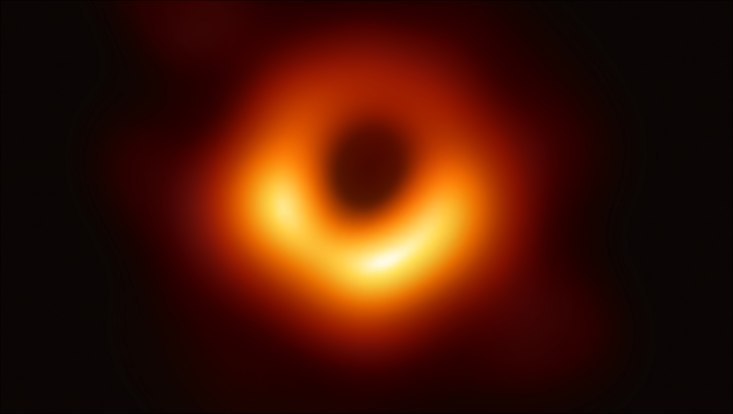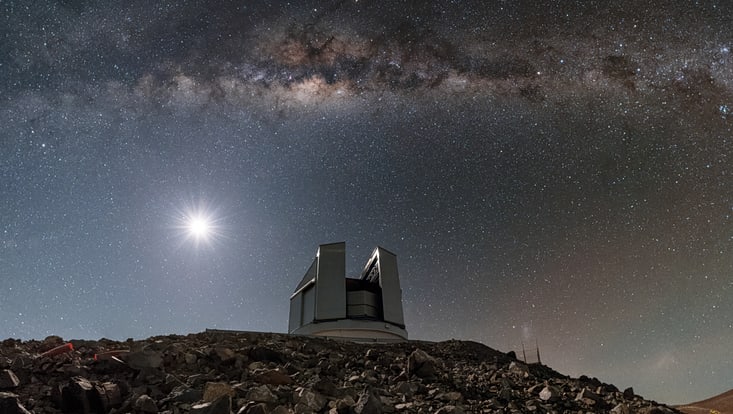Nobel Prize 2020On theorizing and locating black holes
10. Dezember 2020

Foto: Event Horizon Telescope, uploader cropped and converted TIF to JPG, Black hole - Messier 87 crop max res, CC BY 4.0
The Nobel Prize 2020 in Physics honors the outstanding research of Roger Penrose, Andrea Ghez and Reinhard Genzel on black holes. Black holes are considered to be one of the major predictions of Albert Einstein’s General Theory of Relativity from 1915. The proof of their existence and the study of their characteristics has been the subject of intense research activities in the past decades. Cosmologist and particle physicist Prof. Dr. Géraldine Servant and astrophysicist Prof. Dr. Marcus Brüggen talk about the impact of the research of this year’s Nobel laureates for the understanding of black holes.
What are black holes?
Géraldine Servant: Black holes are a prediction of the General Theory of Relativity. They are regions of space where mass is so concentrated that even light photons are unable to escape.
Marcus Brüggen: I think it is important to emphasize here that black holes are extremely compact regions in space. This does not mean that they have infinite density.
Einstein himself remained skeptical about the existence of black holes. How comes that he did not trust in the implications of his own theoretical work?
Géraldine Servant: The term “black hole” did not exist at that time. While this follows from Einstein’s theory, Einstein did not believe in the idea that something could collapse forever, and even trap light. Einstein assumed the Schwarzschild Singularity was an artifact of the mathematics. He argued that a star collapsing would spin faster and would never reach the Schwarzschild Singularity, and that Schwarzschild Singularities do not exist in physical reality. In other words, black holes cannot exist.
Today there is no doubt that the existence of black holes and even the description of their characteristics are consistent with the General Theory of Relativity. What are the achievements of theoretical physicist Roger Penrose in this?
Géraldine Servant: Roger Penrose introduced new mathematical techniques that triggered a renaissance of investigations in the Theory of Relativity. He proved that black holes were not science fiction and described them in detail. Together with Stephen Hawking, he showed the necessity for cosmological singularities: This state, which we call a singularity, is a generic expectation when enough matter clumps together, even in a generic situation with no special symmetry. Penrose proved that black holes can arise from the gravitational collapse of massive, dying stars.
Black holes swallow light and matter that passes their event horizon and it is therefore impossible to see them. How can we then locate black holes?
Marcus Brüggen: You can find them by looking at the motions of objects around them. In this case, they used mainly stars that orbit very close to the black hole, which itself is shrouded in a cloud of gas and dust. By analyzing their orbits, one can infer the mass inside of this orbit. This method has yielded the most precise determination of a black hole’s mass. The stars also become redder when they get closer to the black hole, which is exactly as the Theory of Relativity predicts. One can also study black holes by looking at the radiation that comes from the immediate environment of the black hole, the motion of gas around or, in the case of merging black holes, with gravitational waves.
Scientists agree that the Universe is full of black holes and it is assumed that many of them are located at the centers of the galaxies. Andrea Ghez and Reinhard Genzel both focused their research on the center of our galaxy by observing the movement of a star named S2. How does their research enhance our knowledge of what is at the center of our galaxy?
Marcus Brüggen: Thanks to their research we know exactly that there is a supermassive black hole at the center of our galaxy. Moreover, we know its mass very accurately. Their achievement is also a testament to modern technology, as well as international scientific cooperation. Their work was only possible through the use of the most powerful telescopes on Earth and the use of very advanced techniques such as adaptive optics and interferometry with which several telescopes are connected to act as a larger one. In Reinhard Genzel’s work, large parts of the research were done on facilities of the European Southern Observatory (ESO). ESO is an intergovernmental organization with its headquarters near Munich, in which 16 countries cooperate to build and operate facilities that go beyond the capabilities of individual countries.
In what way are the achievements of the three Nobel laureates important for the research done at Quantum Universe?
Marcus Brüggen: Black holes are regarded as the litmus test for gravity, and our excellence cluster Quantum Universe is all about gravity. We study black holes from the quantum level all the way to the phenomena with which black holes drive massive jets into their surroundings. Moreover, we have a research area devoted to gravitational waves, that are also closely tied to black holes.
Géraldine Servant: Black holes are not only fascinating for astrophysicists. They also serve as very interesting probes of particle physics. We use them to constrain properties of dark matter and very light axion-like particles, that might constitute dark matter. Alternatively, or in addition, dark matter could be in the form of primordial black holes whose production mechanism in the very Early Universe is tied to cosmological inflation. All these topics are part of the Quantum Universe portfolio. Finally, the appearance of a black hole singularity in General Relativity indicates that General Relativity is inaccurate at very small scales. A new theory is needed to resolve these singularities and to describe physics at very small scales and strong gravitational effects. This keeps mathematical physicists busy who work on quantum theories in the cluster. In fact, the interior of a black hole is the main frontier for theoretical physics.


